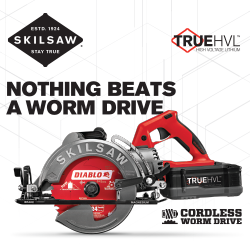
A little over a year ago Rotozip launched the ZipSaw RFS1000-20 ($89, Ohio Power Tool) and then more recently Dremel a similar tool with the Saw-Max SM20-02 ($129, Ohio Power Tool). Because the two are fairly similar we thought it might be helpful to look at some of the differences between the two units. Their price points and barrage of TV commercials will no doubt make both hot holiday gift items this year but which one is right for you (or whomever is receiving it)?
Rotozip ZipSaw RFS1000-20

The ZipSaw was the first of the two and really a very smart design. The unit is basically a grinder that has been designed specifically as a cutoff tool, which makes it much more ergonomic and easier to use. Tile guys especially mostly use grinders just as cutting tools and with all the other Rotozip tools (see our review & video) already targeting these tasks it made a lot of sense to provide this additional option. There was also a need for a flush cut / jamb saw that was a little more multitasking.
The ZipSaw uses 4” XWheels or 3.5” ZipWheels with a variety of functions for cutting wood, metal, plastic, ceramics, masonry and more. The Zipsaw uses a 5/8”-11 spindle which also means it can work with a variety of other accessories and other brands 4” Type 1 wheels you may currently prefer.
Dremel Saw-Max SM20-02
We are not going to go into depth here but instead encourage you to read our recent blog review of the Saw-Max SM20-02 to get a better idea of how the Dremel tool works and what accessories it has.
Head to Head Comparison

Just to be clear both the Dremel and Rotozip companies are under the Robert Bosch Tool Corporation, parent company so they really are targeting different customers it’s not just in our heads. The Dremel Saw-Max has the advantage of launching a year later so the hope is certainly they learned something from their Rotozip counter parts and made some improvements.
Under the hood we find the Rotozip uses a 7.0 amp grinder motor at 11,000rpm while the Dremel uses a 6.0 amp worm drive configuration (found to give more power in circular saw applications) spinning at 17,000rpm. The Rotozip uses a more common 5/8”-11 spindel and larger 4” blades which spin at a rate to allow for a wide range of other common accessories. One complaint we had here was too many flanges, washers, hex keys, spanner wrenches and screws to get on and off. The Dremel on the other hand uses a smaller spindle and flange which use only their 3” proprietary blades but at least keep it simple on with just one flange and hex key.

In use we found each to have their own advantages, the Saw-Max has an easier spindle lock, very nice depth adjustment and cutting guide on the front. This tool is great for cutting strait lines in material with control and accuracy without having to look from the side at the blade. Since the ZipSaw is setup more like a grinder it does not have the depth adjustment or front guide. For professionals used to using a grinder this may feel more natural but definitely not for a first time user.
Obviously there is a $40 price difference here so we will take a look at what is in the box to explain some of the difference things you get for the money. The ZipSaw currently comes with a holiday promotion for a Free Multi-Purpose Carbide blade XW-MP1 ($22, Ohio Power Tool) in the box, so that is a very nice bonus. Also in the box you also get a Wood XWheel, Tile ZipWheel, side handle, universal dust collection hose and all the flanges/wrenches/keys. What we were missing the most here is a case or bag for all these accessories and wrenches which if you lose one your hosed.

We would also strongly recommend if you get the ZipSaw also getting the Cubic Boron Nitride metal wheel XW-MET1 ($20, Ohio Power Tool) which does a very nice job on metal and will last a little while. Both tools have abrasive wheel options for cutting metal but they are really pretty weak options and with the shrinking nature of abrasive wheels they are worthless in no time. In either case we would not recommend it for cutting 1/4" steel like we did in the picture above, thin sheets, gutters, siding, small pipe, etc would really be the max for either of these tools.
The Saw-Max does come with a nice plastic case to store all the blades and hex key needed to change the blades. It also includes a full mix of accessories as well as a 2×4” cutting guide (although this would not be our first tool of choice for cutting 2×4”). It also has a vacuum attachment but we found it did not have the universal fit of the Rotozip and we had to secure it with some gorilla tape.
Overall
The Dremel Saw-Max has some real nice advantages with its guide plate, depth adjustment and sight line this may actually be our new favorite tool for working with large sheets of plywood or drywall. It is very easy to use and not intimidating at all, perfect for any experience levels.


One quick note we found interesting, while the Rotozip will take the 4” blades and Dremel only 3” they both have the same cut depth of ¾” because of the tighter design on the Dremel. At the higher RPM of the smaller wheels we felt this perhaps made up for the smaller amperage motor as we really didn’t see much difference in cutting speed between the two units.

The ZipSaw had a more familiar feel for professionals looking for an improved grinder feel. It also has a wider opening for flush cutting into corners and maneuvering into tight spaces. The accessory options for Rotozip are much larger with more proprietary options but also a whole world of other very common diamond wheels, abrasives and other products you can get at any professional supply house.
We really like both of these tools and as you can see there are pros and cons with each. To really confuse the situation we would also throw in the variable speed Rotozip RZ2000-52 ($149, Ohio Power Tool) with XShield that will give you even more options for tooling in addition to XWheels and ZipWheels and has a depth adjustment.



